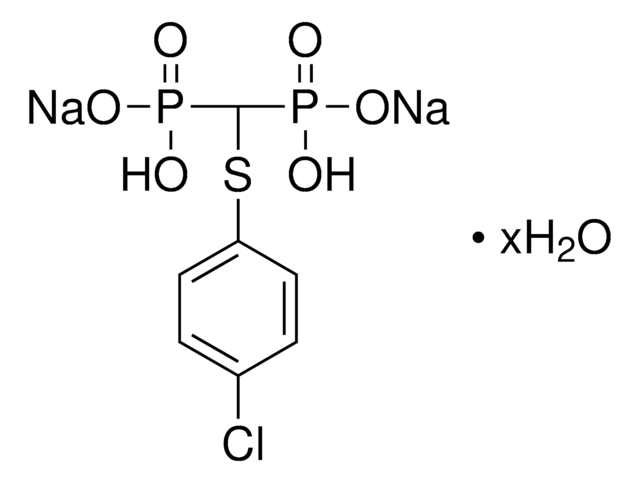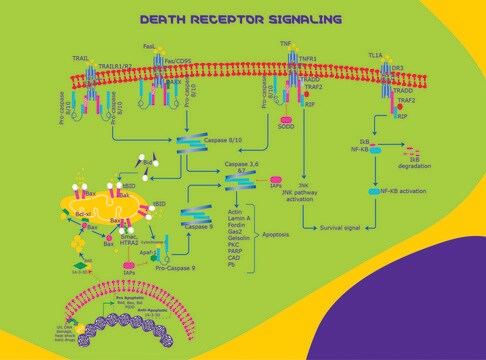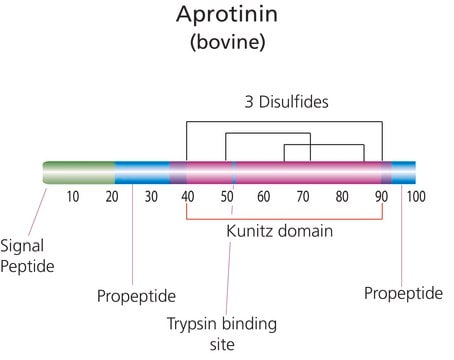T9701
TRAIL human
recombinant, expressed in E. coli, ≥98% (SDS-PAGE and HPLC), lyophilized powder
Sinônimo(s):
Apo2 Ligand, Apo2L, TL2, TNF-related apoptosis-inducing ligand
Faça loginpara ver os preços organizacionais e de contrato
About This Item
Produtos recomendados
fonte biológica
human
Nível de qualidade
recombinante
expressed in E. coli
descrição
extracellular domain
Ensaio
≥98% (SDS-PAGE and HPLC)
Formulário
lyophilized powder
peso molecular
19.6 kDa
predicted mol wt ~21 kDa
técnica(s)
immunofluorescence: suitable
Impurezas
endotoxin, tested
nº de adesão UniProt
temperatura de armazenamento
−20°C
Informações sobre genes
human ... TNFSF10(8743)
Procurando produtos similares? Visita Guia de comparação de produtos
Aplicação
Human TRAIL can be used as a selection agent for treating human cells for phenotypic enrichments. The product can also be used in chemical transfection for identifying Small RNA Modulators of TRAIL-Induced Apoptosis Pathway by utilizing libraries of synthetic small interfering RNA (siRNA) and microRNAs (miRNA).
TRAIL human has been used in immunofluorescence analyses, to study the delocalization of melanoma antigen-D2 in the nucleoplasm after a cellular stress.
Ações bioquímicas/fisiológicas
TNF-related apoptosis-inducing ligand (TRAIL) is a type II transmembrane protein that belongs to TNF family. The product present in both soluble as well as membrane-bound form, can induce rapid apoptosis of various transformed cell lines but not the normal cells. Additionally, the product can also induce apoptotic cell death in TRAIL-sensitive U343MG cells.
TRAIL is a cytokine with anti-inflammatory, and antitumor activity. It is expressed in various cells including immune cells, vascular cells and adipocytes. TRAIL is associated with vascular endothelial cell protection.
Type II transmembrane protein of the TNF superfamily. Ligand for apoptosis-inducing death receptors DR4 and DR5, decoy receptors DcR1 and DcR2, and osteoprotegerin. Approximately 28% amino acid sequence identity to FAS ligand. Human and mouse TRAIL share 65% sequence identity.
forma física
Lyophilized from phosphate buffered saline
Nota de análise
The biological activity is determined by its ability to induce apoptotic cell death in TRAIL-sensitive LN-18 cells.
Código de classe de armazenamento
11 - Combustible Solids
Classe de risco de água (WGK)
WGK 3
Ponto de fulgor (°F)
Not applicable
Ponto de fulgor (°C)
Not applicable
Escolha uma das versões mais recentes:
Já possui este produto?
Encontre a documentação dos produtos que você adquiriu recentemente na biblioteca de documentos.
Os clientes também visualizaram
Lower maternal serum tumor necrosis factor-related apoptosis-inducing ligand (TRAIL) levels in early preeclampsia. A retrospective study
Morano D, et al.
Pregnancy hypertension, 12, 1-5 (2018)
Jan E Carette et al.
Nature biotechnology, 29(6), 542-546 (2011-05-31)
Insertional mutagenesis in a haploid background can disrupt gene function. We extend our earlier work by using a retroviral gene-trap vector to generate insertions in >98% of the genes expressed in a human cancer cell line that is haploid for
Melanoma antigen-D2: a nucleolar protein undergoing delocalization during cell cycle and after cellular stress
Pirlot C, et al.
Biochimica et Biophysica Acta - Molecular Cell Research, 1863(4), 581-595 (2016)
Synergistic effect of TRAIL and irradiation in elimination of glioblastoma stem-like cells
Liu J, et al.
Clinical and Experimental Medicine, 1-13 (2018)
Fatih Birtekocak et al.
Iranian journal of pharmaceutical research : IJPR, 20(2), 45-56 (2021-09-28)
Colon cancer is one of the most prominent causes of cancer-related morbidity and mortality and curable if detected in the early stages. TNF-related apoptosis-inducing ligand (TRAIL) is a therapeutic protein and has a potential anti-cancer activity that is widely used
Nossa equipe de cientistas tem experiência em todas as áreas de pesquisa, incluindo Life Sciences, ciência de materiais, síntese química, cromatografia, química analítica e muitas outras.
Entre em contato com a assistência técnica








